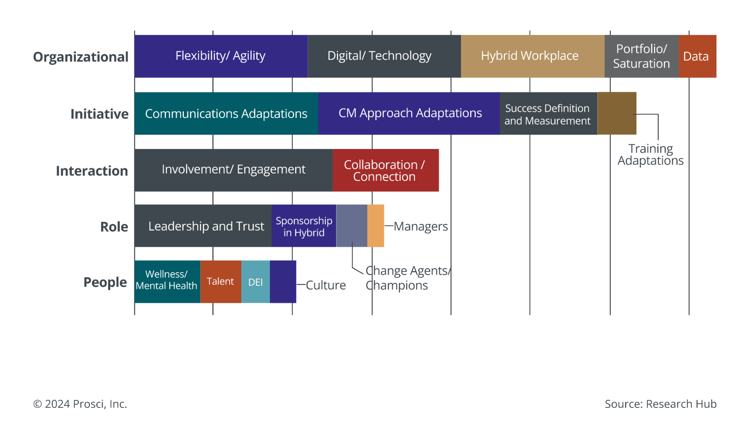How to Successfully Navigate Culture Change Management
Over 20 years, we’ve learned that changing a company’s culture is tough. Often, new plans fail because people aren’t on board—and some don’t even get along. This is where good culture change management helps.

At Prosci, we use a clear, step-by-step plan to manage culture change. A plan helps get everyone involved and reduces resistance. It’s a good approach that ensures employees are more connected so that communication improves and the company’s goals match its culture—leading to lasting improvements.
This guide shows you how to understand your company’s culture, get everyone’s support, and implement effective culture change, making your company stronger and more adaptable.

Understanding Culture Change Management and Why It Matters
Workplace culture reflects the collective attitudes and behaviors of employees. Thus, culture change in the workplace is more than just a strategic shift—it’s a transformation of beliefs and behavior. The change influences everything from employee satisfaction to business goals.
Change to an organization’s culture can happen for many reasons—a merger or acquisition, senior leadership changes, hiring practices, or an intentional change to how the company thinks and operates. During the pandemic, for example, leaders recognized the significance of culture change management as the work environment, interpersonal communications, and employee expectations needed changing.
Unsurprisingly, 87% of respondents in the Prosci Best Practices in Change Management – 12th Edition study cited understanding organizational cultural awareness as important or very important.
Importance of Organizational Culture Awareness

Culture change management is integral for survival in today’s constantly evolving business landscape because an organization’s employee base often isn’t local anymore. The diversity of employees reflects regions and cultures all over the world. This means they value different things and are motivated by different things. Culture isn’t a one-dimensional homogeneous group.
The virtual landscape also means we have fewer touchpoints and are more likely to miss behavior cues. Much more intention is required.
Prosci research on emergent contributors to change success reflects this reality, revealing culture change management as one of the top five contributors to long-term success in the post-pandemic era.
Contributors to Success That Are Emerging or Growing in Importance
Managing Culture Change Effectively
Your first step toward successful change is to understand what’s changing. In rapidly evolving industries, aligning culture change initiatives with broader business strategies is crucial. During culture changes, we advise clients to break down the initiatives into specific behaviors. What are you actually asking people to do differently? The closer their behaviors connect to the outcomes of a strategic initiative, the more credibility they have. Typically, it also allows behavior to connect to the bottom line.
We recommend utilizing the Prosci 10 Aspects of Change Impact model to capture a yesterday-versus-tomorrow view to understanding what’s changing.
Prosci 10 Aspects of Change Impact

While each impact of the 10 aspects is key in building your change plan, leadership should focus on critical behaviors and mindsets.
Critical behaviors: Your key to immediate change
Critical behaviors are the near-term changes you want to see in your organization’s culture. These require a senior-level leadership commitment. Leadership’s active and visible display of these behaviors is essential for long-term behavior changes to take hold in people across the organization.
Using sponsor coalitions and change agent networks is critical for instilling the behaviors you’re looking for while supporting the people who must adopt them.
Example: Steps to deploying culture change management in DEI
An organization wanted to encourage more inclusive meetings as a part of its diversity, equity, and inclusion (DEI) initiative. Prosci helped the organization successfully implement the change by following these steps:
- We spoke with employees across the organization to better understand what inclusion meant to them and how they would like to be included. This helped both define a future vision and identify early adopters.
- Once senior leaders outlined these new principles, we could enlist a coalition of other leaders and use them as change agents to demonstrate early wins.
- This approach helped employees to experience the new culture being implemented by influential networks.
The positive outcomes showed up in that year’s engagement survey six months later.
Mindset shifts: Long-term goals
Changing how employees think and act at work takes time. It usually takes about 18 months for mindset shifts because everyone needs to start doing things differently and make that the new normal. The key to making change easier is using a common change management language. Working together towards change is easier when everyone understands the same terms and ideas.
Prosci uses this approach to implement change management within organizations. Our goal is to build a change-ready culture where everyone is familiar with:
- The Prosci ADKAR® Model – Awareness, Desire, Knowledge, Ability and Reinforcement. It’s a sequential framework that enables people to move through their individual transitions, break through barriers, and get the support they need for success.
- The CLARC roles for people managers – Communicator, Liaison, Advocate, Resistance manager and Coach. Communicators share information, liaisons connect different groups, advocates champion the change, resistance managers remove barriers to change, and coaches help guide everyone. Individual contributors know their roles and can support the outcomes during change.
- Executives perform the ABCs of Sponsorship – Active and visible participation throughout the change, Building a coalition of sponsorship, and Communicating support and promoting the change to impacted groups.
Culture can mean many things to different organizations. But if you break it down into different aspects, the change becomes much more manageable.
The first step is ensuring everyone knows why the change is happening and wants to help make it happen. Then, training helps everyone understand how to make the change work individually. With effective change management, people from all levels of the organization can be successful in adopting a culture change.
